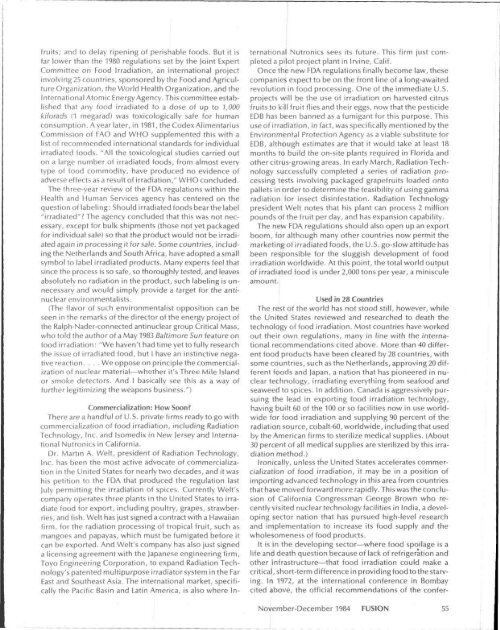Create successful ePaper yourself
Turn your PDF publications into a flip-book with our unique Google optimized e-Paper software.
fruits; and to delay ripening of perishable foods. But it isfar lower than the 1980 regulations set by the Joint ExpertCommittee on Food Irradiation, an international projectinvolving 25 countries, sponsored by the Food and AgricultureOrganization, the World Health Organization, and theInternational Atomic Energy Agency. This committee establishedthat any food irradiated to a dose of up to 1,000kilorads (1 megarad) was toxicologically safe <strong>for</strong> humanconsumption. Ayear later, in 1981, the Codex AlimentariusCommission of FAO and WHO supplemented this with alist of recommended international standards <strong>for</strong> individualirradiated foods. "All the toxicological studies carried outon a large number of irradiated foods, from almost everytype of food commodity, have produced no evidence ofadverse effects as a result of irradiation," WHO concluded.The three-year review of the FDA regulations within theHealth and Human Services agency has centered on thequestion of labeling: Should irradiated foods bear the label"irradiated"? The agency concluded that this was not necessary,except <strong>for</strong> bulk shipments (those not yet packaged<strong>for</strong> individual sale) so that the product would not be irradiatedagain in processing it <strong>for</strong> sale. Some countries, includingthe Netherlands and South Africa, have adopted a smallsymbol to label irradiated products. Many experts feel thatsince the process is so safe, so thoroughly tested, and leavesabsolutely no radiation in the product, such labeling is unnecessaryand would simply provide a target <strong>for</strong> the antinuclearenvironmentalists.(The flavor of such environmentalist opposition can beseen in the remarks of the director of the energy project ofthe Ralph-Nader-connected antinuclear group Critical Mass,who told the author of a May 1983 Baltimore Sun feature onfood irradiation: "We haven't had time yet to fully researchthe issue of irradiated food, but I have an instinctive negativereaction. . . .We oppose on principle the commercializationof nuclear material—whether it's Three Mile Islandor smoke detectors. And I basically see this as a way offurther legitimizing the weapons business.")Commercialization: How Soon?There are a handful of U.S. private firms ready to go withcommercialization of food irradiation, including RadiationTechnology, Inc. and Isomedix in <strong>New</strong> Jersey and InternationalNutronics in Cali<strong>for</strong>nia.Dr. Martin A. Welt, president of Radiation Technology,Inc. has been the most active advocate of commercializationin the United States <strong>for</strong> nearly two decades, and it washis petition to the FDA that produced the regulation lastJuly permitting the irradiation of spices. Currently Welt'scompany operates three plants in the United States to irradiatefood <strong>for</strong> export, including poultry, grapes, strawberries,and fish. Welt has just signed a contract with a Hawaiianfirm, <strong>for</strong> the radiation processing of tropical fruit, such asmangoes and papayas, which must be fumigated be<strong>for</strong>e itcan be exported. And Welt's company has also just signeda licensing agreement with the Japanese engineering firm,Toyo Engineering Corporation, to expand Radiation Technology'spatented multipurpose irradiator system in the FarEast and Southeast Asia. The international market, specificallythe Pacific Basin and Latin America, is also where InternationalNutronics sees its future. This firm just completeda pilot project plant in Irvine, Calif.Once the new FDA regulations finally become law, thesecompanies expect to be on the front line of a long-awaitedrevolution in food processing. One of the immediate U.S.projects will be the use of irradiation on harvested citrusfruits to kill fruit flies and their eggs, now that the pesticideEDB has been banned as a fumigant <strong>for</strong> this purpose. Thisuse of irradiation, in fact, was specifically mentioned by theEnvironmental Protection Agency as a viable substitute <strong>for</strong>EDB, although estimates are that it would take at least 18months to build the on-site plants required in Florida andother citrus-growing areas. In early March, Radiation Technologysuccessfully completed a series of radiation processingtests involving packaged grapefruits loaded ontopallets in order to determine the feasibility of using gammaradiation <strong>for</strong> insect disinfestation. Radiation Technologypresident Welt notes that his plant can process 2 millionpounds of the fruit per day, and has expansion capability.The new FDA regulations should also open up an exportboom, <strong>for</strong> although many other countries now permit themarketing of irradiated foods, the U.S. go-slow attitude hasbeen responsible <strong>for</strong> the sluggish development of foodirradiation worldwide. At this point, the total world outputof irradiated food is under 2,000 tons per year, a minisculeamount.Used in 28 CountriesThe rest of the world has not stood still, however, whilethe United States reviewed and researched to death thetechnology of food irradiation. Most countries have workedout their own regulations, many in line with the internationalrecommendations cited above. More than 40 differentfood products have been cleared by 28 countries, withsome countries, such as the Netherlands, approving 20 differentfoods and Japan, a nation that has pioneered in nucleartechnology, irradiating everything from seafood andseaweed to spices. In addition, Canada is aggressively pursuingthe lead in exporting food irradiation technology,having built 60 of the 100 or so facilities now in use worldwide<strong>for</strong> food irradiation and supplying 90 percent of theradiation source, cobalt-60, worldwide, including that usedby the American firms to sterilize medical supplies. (About30 percent of all medical supplies are sterilized by this irradiationmethod.)Ironically, unless the United States accelerates commercializationof food irradiation, it may be in a position ofimporting advanced technology in this area from countriesthat have moved <strong>for</strong>ward more rapidly. This was the conclusionof Cali<strong>for</strong>nia Congressman George Brown who recentlyvisited nuclear technology facilities in India, a developingsector nation that has pursued high-level researchand implementation to increase its food supply and thewholesomeness of food products.It is in the developing sector—where food spoilage is alife and death question because of lack of refrigeration andother infrastructure—that food irradiation could make acritical, short-term difference in providing food to the starving.In 1972, at the international conference in Bombaycited above, the official recommendations of the confer-November-December 1984 FUSION 55
















